Abstract
The apple snail Pila globosa is a widely distributed mollusc in tropical freshwater ecosystems, where it plays a crucial ecological role. This study examined the morphometric features, condition indices, and reproductive traits of P. globosa to gain insights into its population structure in the Ratargul Freshwater Swamp Forest, Bangladesh. Water quality parameters were recorded, and various morphometric measurements were analysed, including their correlations and seasonal variations. The mean values for shell length, shell weight, shell width, spiral length, base length, aperture length, aperture width, and soft tissue wet weight were 4.64 ± 0.97 cm, 38.29 ± 15.27 g, 3.56 ± 0.74 cm, 2.32 ± 0.51 cm, 3.33 ± 0.74 cm, 3.46 ± 0.64 cm, 2.01 ± 0.45 cm, and 18.05 ± 11.39 g, respectively. Linear regression analyses revealed strong correlations among length–length and length–weight parameters, indicating consistent growth patterns. Monthly frequency distributions showed distinct variations in shell size and form. The sex ratio was 1:1.23 (male–female), not significantly different from parity. Histological analysis during the rainy season revealed reproductive activity, including mature ova, previtellogenic and vitellogenic oocytes, and spermatogonia and spermatids. These findings enhance understanding of the species’ biology and its interaction with environmental conditions, offering valuable data for the conservation and management of freshwater mollusc populations in wetland ecosystems.
1. Introduction
The snail plays a significant role in the aquatic ecosystem in sustaining healthy environments and is an essential species for conserving biodiversity by acting as a biofilter [1,2]. The apple snail, Pila globosa, is one of the highly occupied freshwater gastropods in the tropical region of the Indian Subcontinent [3,4]. P. globosa has also been found in Nepal, Africa, Southwestern Asia, North and South America, and Africa [5]. It can be noticed in large quantities in both temporary and permanent water bodies, including ponds, drains, waterways, paddy fields, and other wetland areas of Bangladesh [6,7]. Unfortunately, wild snail populations in Bangladesh have recently experienced dramatic declines (15–30%) due to indiscriminate overfishing by fishing nets and gears, fishing by poisoning, dewatering of wetlands for fisheries and irrigation, habitat loss and degradation, agricultural intensification, and lack of controls in the use of pesticides, insecticides, etc [6,8,9]. However, P. globosa has an amphibious form of life and has developed well-adaptive characteristics to survive in various habitats, from small freshwater reservoirs to wet soil [10,11]. They can undergo hibernation and aestivation in harsh, dry, and winter seasons, which makes them potential model organisms for studying environmental pollution and anthropogenic effects [12].
The culture of different molluscs is prevalent in various regions of Asia [13,14], while snail farming has not attracted any interest in Bangladesh. Because Bangladeshi people do not take apple snails as food items, some tribal groups of people consume them as their food [15]. The snail flesh is edible and highly proteinaceous (33.81%); therefore, many approaches have been made to use them as feed for prawn (Macrobrachium rosenbergii) farms in the southwestern part of Bangladesh [8,16]. Chopped snail flesh is also used as a supplementary feed for catfish farms, and most traditional duck farms use snails as the main protein source for their birds [17]. Additionally, the calcareous shell is used as raw material to produce edible lime, which is used as a delicacy with betel nut in Bangladesh [8,9]. P. globosa and Bellamya bengalensis are typically collected for commercial use as feed for shrimp farms in coastal Bangladesh [9]. In particular, their overuse of prawn farming and commercial edible lime production puts them at an alarming level [8]. However, the overuse of these natural snails for commercial purposes is threatening their population in natural waters. Urgent action is needed to conserve these species, as they play a crucial role in the region’s ecological and economic balance.
Morphometrics and dynamics of condition indices are key in determining the reproductive peak and spawning success in aquatic animals [18,19]. Seasonality in gonadal maturation and histological characterization of developmental phases provides consistent information on the onset of physiological changes in aquatic animals [20,21]. Morphometric properties are used as tools to correlate with each other, as well as water quality parameters [22,23]. Bridging the correlation among morphometrics, physicochemical parameters, and reproductive parameters provides a valuable source of information for future conservation and resource management schemes [24,25]. Insight into reproductive features and behaviour is an essential tool for conservation biology [18,26,27]. This study investigates the reproductive ecology of Pila globosa in the Ratargul Freshwater Swamp Forest, Bangladesh, linking morphometric traits and breeding patterns to environmental factors. It identifies ecological thresholds essential for reproduction and uncovers adaptive strategies and habitat-specific limitations. Unlike previous isolated studies, this multidimensional approach integrates morphometric analysis, condition indices, reproductive traits, and water quality parameters to understand how dynamic freshwater environments influence reproductive success. The tropical swamp forest offers seasonal variation, enabling ecological observations critical for assessing reproductive adaptations. Notably, no prior research has explored the population biology, breeding behaviour, or environmental conditions of P. globosa in this unique habitat. This study fills that gap by analysing correlations between morphometric measurements, evaluating temporal population dynamics, and assessing the relationship between water quality and snail morphology. The findings provide essential baseline data for conservation and sustainable aquaculture of this ecologically and economically important mollusc species.
2. Materials and Methods
2.1. Study Area, Water Qualities, Sample Collection, and Morphometric Measurement
The Ratargul Swamp Forest in Bangladesh is one of the few unique freshwater ecosystems in Southeast Asia with diverse plant and animal assemblages [28,29], covering an area of 13.45 km2 [30]. This habitat is a specialised forest system with seasonal inundation and flooding events that allow the formation of different trophic realms [31,32]. A total of 32 random samples of P. globosa were collected in each month from the swamp forest between September 2021 and August 2022 (Figure 1). Samples were acquired in the first half of each month. They were brought to the laboratory, cleaned with tap water, and placed on a paper towel to remove excess moisture and dirt. The key environmental characteristics were determined on-site using YSI Multi-sensor Pro, Professional Plus, USA. A digital balance was used to weigh the samples. Different morphometric measurements were taken using a digital Vernier scale as described by Panda et al. [33] (Supplemental Figure S1). The animals were then dissected to determine their sexual status and the maturation phase of the gonads. A sample of the gonad was preserved in 10% neutral buffered formalin for histological analysis.
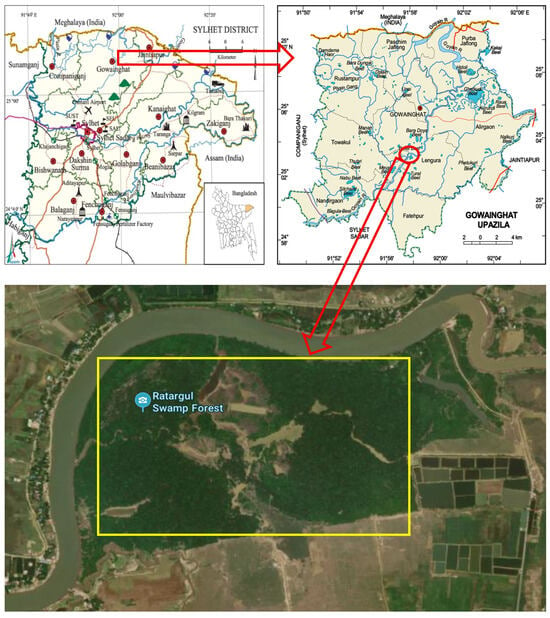
Figure 1.
Location of the Ratargul Swamp Forest, Sylhet, Bangladesh [34].
2.2. Tools for the Analysis of Morphometrics
The measurement of condition indices was performed according to the general condition index (CI) measurement protocol from Uddin et al. [35], which involved the ratio between the wet tissue weight and the sundried (2 h) dry weight of the shell in the same unit, and Fulton’s condition index KF [36]. The shells were sun-dried for 3 h before considering their weight for CI measurement. The length–weight parameters were established by constructing a logarithmic regression between different morphometrics as described by Froese et al. [37]. The sex ratio of each sampling period was evaluated, and a standard chi-square test was performed as per the description of Hattori et al. [38] to determine whether the observed sex ratio differed significantly from the theoretical 1:1 ratio. The relative condition factor was computed as KR = W/aLb [39], and allometric condition factor KA = W/Lb [40], where W stands for the weight of the shell (g), L stands for the length of the shell (cm), and a and b represent the parameters of the relationship between length and weight obtained from the regression plots.
2.3. Gonadal Maturation Phases and Histological Procedure
The mature and immature stages in both male and female gonads were characterised by the methodology and features of Lee [41]. The NBF sample went through repetitive cleaning with fresh water, xylene, and a series of alcoholic dehydration. The histology procedure was based on the description of Dennis et al. [42] and gonadal cells were identified by following the criteria from Lee [41] and Rodrigues et al. [43].
2.4. Statistical Analyses
Descriptive statistics and ANOVA were performed in SPSS v26, while regression analysis, frequency distribution, and chi-square test were conducted by using data tools in the Office 365 version of Microsoft Excel. Statements of normal distribution and homogeneity were tested for ANOVA. Tukey’s HSD post hoc test was adopted to determine the significance between different means at p < 0.05. All morphometric parameters and physicochemical properties of water were compared by using one-way ANOVA, except for the sex ratio and contingency between mature and immature individuals, which were tested on chi-square statistics (p < 0.05). Principal component analysis (PCA) and correlation matrices have been used to illustrate the correlation between full-year morphometrics and water quality data to represent the overall trend throughout the study period. PCA and correlation metrics were performed in PAST software v4.06b, and a scatter biplot was constructed for illustration.
3. Results
3.1. Physical and Chemical Properties of Water
Table 1 presents the physicochemical properties of water in the Ratargul Swamp Forest from September 2021 to August 2022. The water temperature varied significantly (p < 0.05) by month, with the highest recorded in August (29.50 ± 0.44 °C), followed by September and July, while the lowest was noted in January (17.22 ± 0.85 °C). The dissolved O2 levels ranged from 3.42 ± 0.54 to 5.57 ± 0.33 mg/L, showing no significant differences throughout the year (p < 0.05). Conversely, the highest conductivity and TDS were observed in February (76.39 ± 1.01 µS cm−1 and 36.82 ± 0.23 ppm, respectively), while the lowest values occurred in May (31.80 ± 0.83 µS cm−1 and 15.14 ± 0.33 ppm, respectively). A significantly higher (p < 0.05) pH value was recorded in June (7.48 ± 0.25), followed by July (7.31 ± 0.21). The light penetration in the water was found to be greatest in August (100.27 ± 1.37 cm), while the least was in April (8.57 ± 0.42 cm) (p < 0.05). The water depth ranged from 0.69 ± 0.15 to 3.05 ± 0.18 m across different months, with significant variations (p < 0.05).

Table 1.
Physicochemical properties of water throughout the year, 2021–2022 (mean ± standard error, n = 3 for each parameter; different superscripts letters (a, b, c and d) refer significant differences at p < 0.05).
3.2. Morphometric Measurement of P. globosa
Table 2 outlines various morphometric measurements in P. globosa. The minimum and maximum shell length (SL) values were recorded at 2.34 cm and 9.31 cm, respectively. Shell weight (SW) varied from 11.23 to 83.56 g, with an average of 38.29 ± 15.27 g. Shell width (SWD) ranged from 1.76 to 6.75 cm, with a mean of 3.56 ± 0.74 cm. In January, the shell length measured 4.95 cm, and the shell weight was 41.47 g. The shell width measured 3.64 cm, spiral length was 2.08 cm, aperture length was 3.32 cm, aperture width was 3.49 cm, base length was 1.95 cm, and soft tissue wet weight was 18.53 g. February showed a slight decrease in shell weight to 33.49 g, but an increase in shell width to 4.04 cm and spiral length to 2.82 cm. March recorded the lowest shell weight at 31.61 g, accompanied by a notable increase in soft tissue wet weight to 23.93 g. In April, the shell weight increased to 42.18 g, while May and June showed relatively stable measurements. July noted a higher spiral length of 2.73 cm and a soft tissue wet weight of 18.15 g. August documented the lowest shell length at 4.12 cm and shell width at 3.17 cm. September and October exhibited moderate values, with October presenting the highest shell weight at 45.02 g. November’s measurements remained consistent with the previous months, while December recorded the highest shell length at 5.13 cm and shell weight at 49.20 g, alongside significant increases in aperture width and base length. These data underscore seasonal variations in shell and soft tissue growth.

Table 2.
Dynamics of the morphometric characters of P. globosa (mean ± standard error; different superscripts letters (a, b, c and d) refer significant differences at p < 0.05).
The minimum spiral length was found to be 1.47 cm, while the maximum was 3.19 cm, with an average of 2.32 ± 0.51 cm. Base length fluctuated between 1.83 and 6.67 cm. The aperture length ranged from 1.36 to 5.63 cm. The aperture width varied from 0.87 to 3.89 cm, with an average of 2.01 ± 0.45 cm. The soft tissue wet weight ranged from 4.25 to 66.63 g, averaging 18.05 ± 11.39 g. The highest shell weight recorded was 89 g, while the lowest was 13 g. The most common shell weights were identified as 20–60 g, and the least common were found to be 13–18 g and 69–89 g. The length–weight frequency plots indicated that the values of both shell length and shell weight were considerably more discrete throughout the sampling period, as reflected by the formation of several class intervals (Figure 2).
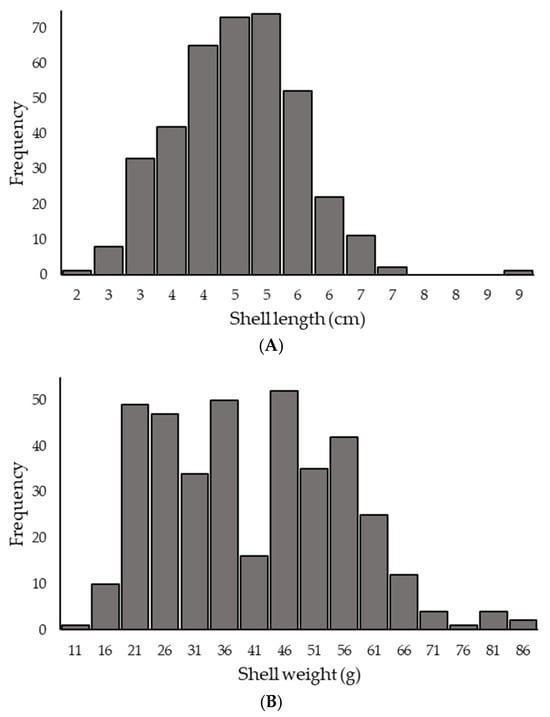
Figure 2.
(A) Length and (B) weight frequencies of P. globosa during the full-year sampling.
3.3. Length–Weight Parameters, Correlation, Condition Indices, and Sex Ratio
The shell width and the base length to the shell length were built with correlation coefficients determination (R2) of 0.64 and 0.56, respectively, demonstrating the moderate correlation between these two morphometrics. Again, regression of spiral length, soft tissue wet weight, and shell length resulted in a weak correlation value (Figure 3). The aperture length–shell length relationship was established with an R2 value of 0.54, which ascribes an average correlation (Figure 3). However, the regression between the aperture and the shell length exhibited a poor value of 0.41, denoting a weak correlation (Figure 3). A total of 384 samples were collected throughout the year in successive months. The number of males was 172 in total, and the number of females was 212 in the total sample. The male and female ratio was established at 1:1.23, which did not vary significantly based on the chi-square (χ2) test (Supplemental Table S1; p = 0.82).
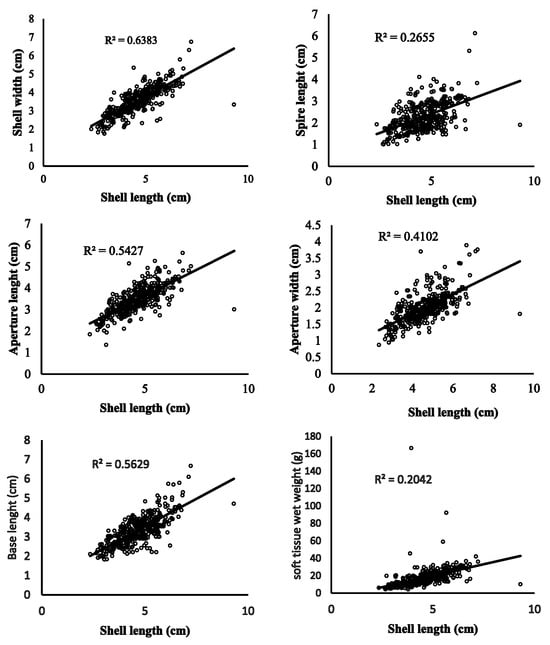
Figure 3.
Relation between different length-based parameters of P. globosa (p < 0.001).
Table 3 shows that the values of the a, b, and R2 parameters for different variables varied between the different length–weight regressions. Among the models, the equation BW = a × SLb (shell length) showed the strongest correlation (R2 = 0.58), with coefficients a = 0.55 and b = 1.50, and 95% confidence intervals of 0.49–0.52 for a and 1.60–1.64 for b. Other models, such as those using base length, spiral length, aperture length, and aperture width, showed lower R2 values (0.27–0.45), indicating weaker predictive power.

Table 3.
a, b, R2, and mortality rate (Mw) parameters for different morphometrics of P. globosa.
The monthly variations in four parameters, KF, KR, KA, and CI, demonstrate distinct seasonal trends (Figure 4). KF values ranged from 27.10 ± 7.93 in February to a peak of 55.20 ± 23.78 in August, indicating a general increase during warmer months (p < 0.05). KR followed a similar pattern, with the lowest value in February (5.21 ± 1.54) and the highest in April (7.65 ± 2.16), suggesting enhanced activity during spring. KA values were lowest in February (2.94 ± 0.87) and highest in October (4.25 ± 0.75), showing moderate seasonal fluctuation (p < 0.05). CI exhibited the greatest variability, with a notable spike in March (53.06 ± 93.34), though most months remained within a narrower range (26.26–48.56). Statistical groupings. These findings suggest that environmental or biological factors influencing these parameters vary seasonally, with peaks generally occurring in spring and summer. Further analysis could clarify the drivers behind these fluctuations.
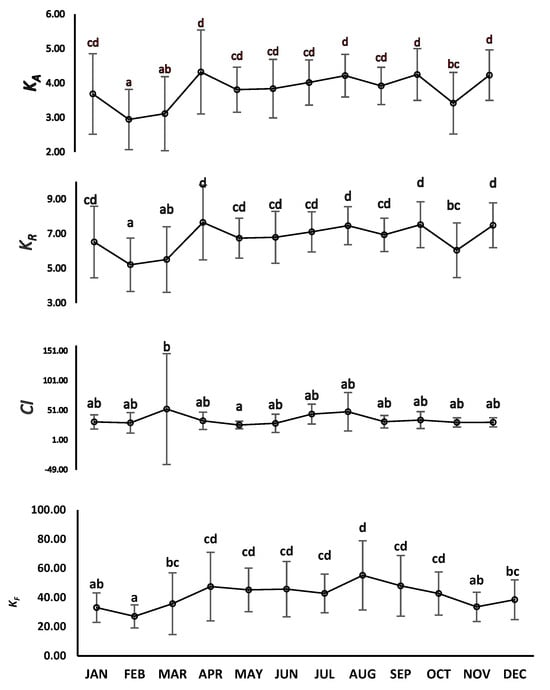
Figure 4.
Monthly dynamics of different condition indices in P. globosa (different superscripts letters i.e., a, b, c and d refer significant differences at p < 0.05).
3.4. Dynamics of Gonadal Maturation Phases and Histological Gonads
Mature individuals were found throughout the year during the sampling period (Figure 5). A moderate percentage of immature snails were observed throughout the year, especially in July, October, and December. However, a chi-square (χ2) test was conducted to assess the contingency between mature and immature individuals throughout the study period (Supplemental Table S2), which showed no significant difference as indicated by a higher p-value (0.95).
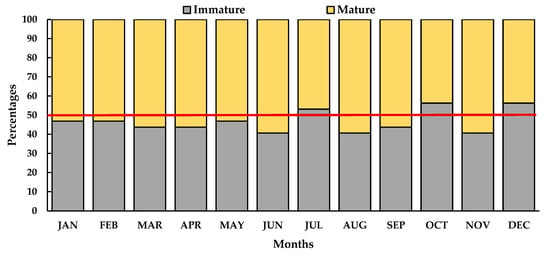
Figure 5.
Percentages of different maturation phases in P. globosa during the sampling period.
The histology of the female gonads reveals the presence of mature oocytes covering the previtellogenic and vitellogenic stages (Figure 6A,B). At the same time, the developing spermatogonia and spermatid cells were spotted in the male gonad (Figure 6C).
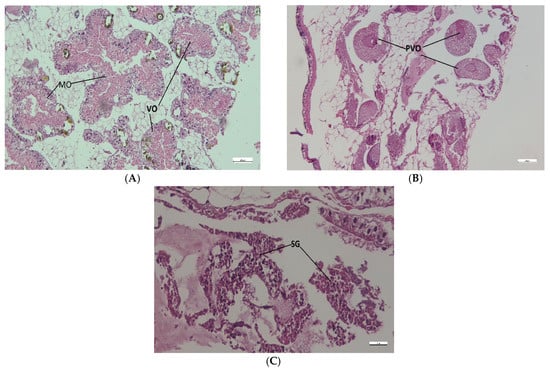
Figure 6.
Histology of mature gonad ((A,B) ovary, (C) testes) of P. globosa (MO—mature oocytes, VO—vitellogenic oocytes, PVO—previtellogenic oocytes, and SG—spermatogonium, scale bar 20 μm).
3.5. The Principal Component Analysis (PCA)
The correlation matrices and PCA for the morphometrics of P. globosa and water quality parameters are shown in Figure 7. The correlation matrix indicates strong positive links among shell morphometrics of P. globosa, including shell length, shell weight, width, spiral length, and soft tissue wet weight, suggesting coordinated structural growth. These traits also positively associate with temperature, conductivity, and total dissolved solids, pointing to optimal growth in warm, mineral-rich environments. Conversely, dissolved oxygen and transparency display significant negative associations with shell metrics, implying limited growth in clearer, oxygen-rich water. These opposing relationships reflect seasonal environmental trade-offs influencing physiology. Water depth exhibits moderate correlations with both trait and parameter sets, underscoring its influence on habitat conditions.
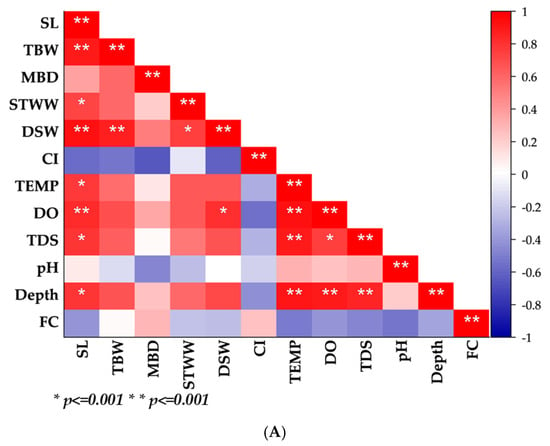
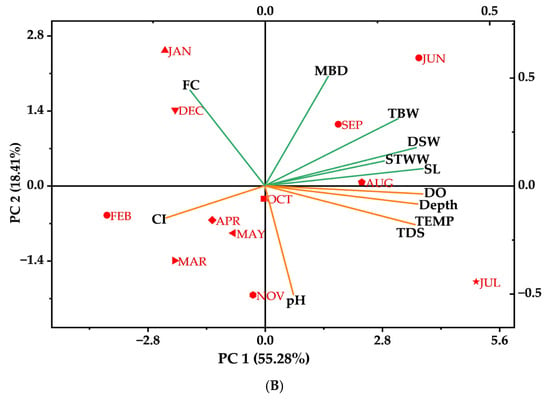
Figure 7.
(A) Correlation matrices and (B) principal component analysis (PCA) of water quality parameters and morphometrics of P. globosa. (SL, shell length; TBW, shell weight; SWD, shell width; MBD, maximum body depth; DSW, dry shell weight; SPL, spiral length; BL, base length; AL, aperture length; AW, aperture width; STWW, soft tissue wet weight; Temperature, temperature; DO, dissolved oxygen; Cond., conductivity; TDS, total dissolved solids; Trans., transparency; WD, water depth).
Again, principal component analysis (PCA) illustrated seasonal variability in water parameters and morphometric traits. PC1 explained 55.28% of the total variance, dominated by shell-related metrics—shell weight, shell length, shell width, spiral length, and soft tissue wet weight, which were positively correlated and directionally aligned. These traits are also grouped with water temperature, conductivity, and total dissolved solids, indicating that regional onsets of warm environments enhance shell development. PC2 accounted for 18.41% of the variance and was strongly influenced by dissolved oxygen and water transparency. These vectors showed distinct loading patterns, suggesting an alternative ecological influence, particularly in cooler, clearer water conditions.
Monthly data points formed seasonal clusters along these gradients. Summer months (April–July) aligned closely with elevated temperature and shell growth variables, while winter months (December–February) corresponded with higher dissolved O2, increased transparency, and reduced morphometric traits. The relative positions of vectors revealed specific relationships: traits such as weight and length exhibited strong positive correlations, while opposing orientations between higher dissolved O2 and temperature suggested an inverse association. The PCA underscores seasonal water quality dynamics as key determinants of P. globosa morphometrics.
4. Discussion
The morphological parameters of aquatic animals provide a model to quantify population dynamics in a particular water body [34,44]. The statistics of different morphometrics in P. globosa indicate that the diversity of the snail population, concerning shape and size, was heterogeneous in the Ratargul Swamp Forest. Prieto [45] reported a maximum shell length value of 8–11 cm for the same species. Sarkar and Krupanidhi [46] obtained a weak to moderately strong relationship between different measurements of length and weight of P. globosa with other gastropods using regression analyses. Again, a similar trend of correlation was also observed between the length, weight, and aperture length of the same species [33]. A positive correlation between shell width and base length to shell length was observed in P. globosa. However, a delicate relationship was reported in aperture width–shell length by Panda et al. [33] that supports the current studies recorded on aperture length and aperture width, as well as shell length. A non-linear relationship was observed in Indoplanorbis exustus between weight and length, with a slow width growth after reaching 1.3 cm shell length by Mantale et al. [47]. Another study on P. globosa by [15] documented a weak correlation of total wet weight and aperture width with shell length that supported the findings of the current study, indicating that significant portions of the samples matured when recorded, thus showing a medium to weak correlation.
The current study illustrates a negative allometric relationship between the parameters depicted by the value b, which is lower than 3. This relationship in gastropods has been supported by the previous report of Jaiswar and Kulkarni [48]. Ngor et al. [49] also reported an allometric length–weight relationship, especially in gastropods, where Pila sp. was dominant. This might be due to environmental factors, as well as geographic variances and reproductive activities. All the values of the Fulton condition factor and other relative conditional factors were based on previously available literature [15,33] and reflect no significant differences.
The length–weight frequency distribution plot represented the heterogeneity in length and weight frequency of the P. globosa population, confirming the different age and size groups for the sustained population [50,51]. Panda et al. [33] found a positive and strong correlation in the temporal scale among the morphometric parameters (shell width, spiral length, base length, aperture length, and shell weight) of P. globosa in India. Water quality is one of the primary factors that influence the growth, abundance, and dispersal of molluscs [52,53,54]. The growth metric of the freshwater limpet Septaria lineata was strongly affected by limnology in India [55] and freshwater snails in Africa [56]. Growth could be hampered by the effects of pollutants and stressors on the physiology of oxidative stress physiology of P. globosa [12]. In the PCA, May was different from the other months due to rain and runoff floods from upstream via the Shari-Goyain River [57]. The morphometrics of P. globosa and the water quality indices were correlated in the current research. No available study has been found to compare the present data on natural mortality (Mw) for P. globosa. Therefore, it was certainly the first attempt to address the status of Mw of P. globosa in a freshwater habitat. Temporal variation in different condition indices has already been reported in this species [33], which might be related to the availability of food and water quality [58]. Morphological traits in P. globosa are expected to be influenced by environmental factors as represented by seasonal dynamics in current research. Notable variation in shell dimensions and weight across regions, linked to habitat conditions and seasonal changes. Diet diversity, especially aquatic macrophytes, affects growth and feeding efficiency.
The P. globosa sexes are identified according to Das et al. [59], although it is difficult to spot the sexes only by morphological states, even in mature stages among the snails [60]. Wu et al. [61] found a lower coverage of the gonad in female snails in P. canaliculata and P. scalaris due to suspected energy expenditure in oocyte development and the albumin gland. In Bangladesh, the snail breeding season has been reported in monsoons that extend from June to September, reaching up to December, as snails require moisture to breed and are, therefore, available when rain or water fills up the pond [8,59], suggesting an abundance of mature individuals at the time, reflected by the high percentage of mature snails in the present study, starting from the early monsoon. The studies also point out the aestivation of snails due to the dry environment and reduced waterbodies, reflected in the low percentage of mature individuals from winter, except in February, perhaps due to sudden rain, which has been previously observed due to meteorological factors. Water availability and temperature may also play a role in sexual dimorphism, reproduction, and development in this study, in addition to a possible biased sex ratio due to random sampling [62]. P. globosa exhibits seasonal reproduction and varied egg-laying strategies as adaptive responses to environmental conditions. Reproduction peaks during favourable seasons to enhance offspring survival when food and water are plentiful. Single egg-laying may reflect higher parental investment per offspring in unpredictable habitats, while multiple egg-laying boosts reproductive output in stable environments [63]. This flexibility aligns with life-history strategies, balancing the quantity and quality of offspring based on ecological cues. However, more extensive research is needed to develop a comprehensive understanding of this phenomenon in the study species.
The Ratargul Swamp Forest in Bangladesh faces significant water pollution from various sources. Agricultural runoff introduces fertilisers and pesticides, disrupting the aquatic ecosystem [64]. Industrial discharges contribute to heavy metals and toxic substances, posing threats to wildlife, and several sources of domestic waste, including plastics and organic matter, lead to harmful substance accumulation and pathogen proliferation [65]. Tourism increases litter and pollutants from recreational activities [66]. The gonadal maturation cycle in snails has already been reported to continue throughout the year [21,41]. However, there was a specific way of gonadal maturation of snails depending on the level of geography, species, and the physicochemical realm of the living medium [67,68]. Although various stages of gonadal maturation are described for snails, the current study only reported a few stages through histological characterisation. This happened due to the selective sampling of mature snails during the rainy season in Bangladesh.
5. Conclusions
In conclusion, this study provides valuable baseline data for future ecological and biological research on P. globosa in the Ratargul Swamp Forest. Over a year, we examined the physicochemical properties of the aquatic environment alongside detailed morphometric measurements of P. globosa. The results revealed significant seasonal fluctuations in both environmental parameters and morphometric indices, indicating dynamic interactions between habitat conditions and molluscan growth. Most water quality parameters, including temperature, dissolved oxygen, pH, and conductivity, remained within optimal ranges for supporting molluscan life, suggesting that the swamp offers a suitable habitat for feeding, growth, and reproduction. The observed variations in shell and soft tissue metrics across months may reflect adaptive responses to environmental changes or reproductive cycles. However, to fully understand the population dynamics, reproductive biology, and ecological preferences of P. globosa, broader-scale studies are necessary. Expanding the sampling to include diverse aquatic habitats across different regions of Bangladesh would provide a more comprehensive understanding of the species’ ecological plasticity and conservation needs. Such data could also inform sustainable management strategies for freshwater molluscs, which play crucial roles in aquatic ecosystems. This study thus lays the groundwork for more extensive, multi-regional investigations into the biology and habitat requirements of P. globosa. A comprehensive ecological study involving broad aspects of biotic and abiotic factors must be considered before reaching a definitive conclusion. Habitat parameters and vegetation should be analysed to determine their correlation with reproduction and growth. Egg-laying strategies, whether single or multiple, should be examined across different seasons. The diversity and availability of food resources must be assessed for their influence on reproductive success.
Supplementary Materials
The following supporting information can be downloaded at: https://www.mdpi.com/article/10.3390/conservation5030043/s1, Supplemental Figure S1: Major morphometric measurements of P. globosa based on the description of Panda et al. [33]; Supplemental Table S1: Chi-square test for sex ratio of male and female P. globosa during the different months of the study period; Supplemental Table S2: Chi-square test for contingency between immature and mature P. globosa during the different months of the study period.
Author Contributions
S.D., M.A.H., G.C., P.S. and M.A.H.—Conceptualisation, methodology, software, validation, formal analysis, investigation, resources; S.D. and G.C.—data curation, writing—original draft preparation; M.H., D.P. and M.K.—writing—review and editing, writing—original draft preparation, resources; M.A.H. and M.M.I.—visualisation, supervision, project administration, funding acquisition. All authors have read and agreed to the published version of the manuscript.
Funding
This project has been funded by the NST (National Science and Technology) fellowship from the Government of the Republic of Bangladesh.
Institutional Review Board Statement
Not applicable.
Informed Consent Statement
Not applicable.
Data Availability Statement
Data will be made available upon reasonable request to the corresponding author.
Conflicts of Interest
The authors declare no conflicts of interest.
References
- Hwang, S.; Lee, Y.; Kim, M.; Kim, B.-H. Filter Feeding and Carbon and Nitrogen Assimilation of a Freshwater Bivalve (Unio douglasiae) on a Toxic Cyanobacterium (Microcystis aeruginosa). Appl. Sci. 2021, 11, 9294. [Google Scholar] [CrossRef]
- Gheoca, V.; Benedek, A.M.; Schneider, E. Exploring Land Snails’ Response to Habitat Characteristics and Their Potential as Bioindicators of Riparian Forest Quality. Ecol. Indic. 2021, 132, 108289. [Google Scholar] [CrossRef]
- Jahan, M.S.; Akter, M.S.; Sar, M.M. Growth Ecology of Pila globosa (Swainson) (Gastropoda: Pilidae) in Simulated Habitat. Pakistan J. Biol. Sci. 2001, 4, 581–584. [Google Scholar] [CrossRef]
- Panda, F.; Pati, S.G.; Das, K.; Samanta, L.; Sahoo, D.K.; Paital, B. Biochemical and Molecular Responses of the Freshwater Snail Pila Sp. to Environmental Pollutants, Abiotic, and Biotic Stressors. Front. Environ. Sci. 2022, 10, 1033049. [Google Scholar] [CrossRef]
- Budha, P.B.; Madhyastha, A.; Dutta, J. Pila globosa. The IUCN Red List of Threatened Species 2010, e.T166694A6261849. Available online: https://www.iucnredlist.org/species/166694/6261849 (accessed on 1 January 2025).
- Shathi, U.H.; Rahman, M.R.; Rahman, R. Ecology and Bio-Economics of Freshwater Apple Snail Pila globosa in Natore District of Bangladesh. J. Sustain. Environ. Manag. 2022, 1, 332–338. [Google Scholar] [CrossRef]
- Jahan, M.S.; Islam, M.R.; Rahman, M.R.; Alam, M.M. Induced Breeding of Pila globosa (Swainson 1822) (Gastropoda: Prosobranchia) for Commercial Farming. Univ. J. Zool. Rajshahi Univ. 1970, 26, 35–39. [Google Scholar] [CrossRef]
- Nahid, S.; Henriksson, P.; Wahab, M. Value-Chain Analysis of Freshwater Apple Snail (Pila globosa)Used for on-Farm Feeds in the Freshwater Prawnfarming Sector in Bangladesh. Int. J. Agric. Res. Innov. Technol. 2013, 3, 22–30. [Google Scholar] [CrossRef]
- Nath, R.D.; Lifat Rahi, M.; Sipar Hossain, G.; Anisul Huq, K.; Anisul, K. Marketing Status of Fresh Water Snail in Khulna District. Bangladesh Res. Pub. J 2008, 1, 337–347. [Google Scholar]
- Panda, F.; Pati, S.G.; Bal, A.; Samanta, L.; Paital, B. Redox Regulatory System in Semi-Sessile Amphibious Indian Apple Snail Pila globosa for Future Ecotoxic Studies. Proc. Natl. Acad. Sci. India Sect. B Biol. Sci. 2022, 93, 443–450. [Google Scholar] [CrossRef]
- Pati, S.G.; Panda, F.; Samanta, L.; Paital, B. Spatio-Temporal Changes in Oxidative Stress Physiology Parameters in Apple Snail Pila globosa as a Function of Soil Mg, Ca, Organic Carbon and Aquatic Physico-Chemical Factors. Environ. Geochem. Health 2023, 45, 2591–2610. [Google Scholar] [CrossRef]
- Panda, F.; Pati, S.G.; Anwar, T.N.; Samanta, L.; Paital, B. Seasonal Variation of Water Quality Modulated Redox Regulatory System in the Apple Snail Pila globosa and Its Use as a Bioindicator Species in Freshwater Ecosystems across India. Water 2022, 14, 3275. [Google Scholar] [CrossRef]
- Nair, D.M. Developments in Molluscs Farming in Southeast Asia. In Responsible Aquaculture Development in Southeast Asia, Proceedings of the Seminar-Workshop on Aquaculture Development in Southeast Asia, Iloilo, Philippines, 12–14 October 1999; Southeast Asian Fisheries Development Center the Aquaculture Department: Iloilo, Philippines, 1999; pp. 103–114. [Google Scholar]
- Hossain, M.A.; Sarker, T.R.; Sutradhar, L.; Hussain, M.; Iqbal, M.M. Toxic Effects of Chlorpyrifos on the Growth, Hemocytes Counts, and Vital Organ’s Histopathology of Freshwater Mussel, Lamellidens marginalis. J. King Saud Univ.—Sci. 2023, 35, 102482. [Google Scholar] [CrossRef]
- Saha, B.; Jahan, M.; Hossain, M. Morphometrics, Length-Weight Relationship and Ecological Factors Affecting the Habitat of Pila globosa (Swainson, 1822) (Mesogastropoda: Pilidae) Located in Rajshahi University Campus. Bangladesh J. Sci. Ind. Res. 2016, 51, 121–128. [Google Scholar] [CrossRef]
- Ghosh, S.; Jung, C.; Meyer-Rochow, V.B. Snail as Mini-Livestock: Nutritional Potential of Farmed Pomacea canaliculata (Ampullariidae). Agric. Nat. Resour. 2017, 51, 504–511. [Google Scholar] [CrossRef]
- Rohaeni, E.S.; Subhan, A.; Hanifah, V.W.; Bakrie, B.; Sumantri, I. Effects of Feeding Alabio Ducks with Fresh Golden Snail on Egg Production and Quality. J. Hunan Univ. Nat. Sci. 2021, 48, 305–313. [Google Scholar]
- Akther, S.; Hossain, M.A.; Pandit, D.; Chowdhury, T.R.; Mian, S. Morphometrics and Reproductive Characteristics of the Freshwater Crab Sartoriana spinigera from the Habitat of Ratargul Swamp Forest, Bangladesh: An Approach to Conservation. Scientifica 2024, 2024, 4550875. [Google Scholar] [CrossRef]
- Chakraborty, A.; Begum, N.; Anam, U.; Gupta, T.; Iqbal, M.M.; Hossain, M.A. Growth Factors and Condition Indices of Some Air-Breathing and Catfishes from Hakaluki Haor, Bangladesh. J. Appl. Ichthyol. 2025, 2025, 7463844. [Google Scholar] [CrossRef]
- Kitai, H.; Kakuda, U.; Goto, S.G.; Shiga, S. Photoperiod Controls Egg Laying and Caudodorsal Cell Hormone Expression but Not Gonadal Development in the Pond Snail Lymnaea stagnalis. J. Comp. Physiol. A 2021, 207, 523–532. [Google Scholar] [CrossRef]
- Pewphong, R.; Kitana, J.; Kitana, N. Chronology of Gonadal Development in the Malayan Snail-Eating Turtle Malayemys Macrocephala. Zool. Stud. 2020, 59, e20. [Google Scholar] [CrossRef]
- Dominguez, E.; Abdala, V. Morphology and Evolution of the Wing Bullae in South American Leptophlebiidae (Ephemeroptera). J. Morphol. 2019, 280, 95–102. [Google Scholar] [CrossRef]
- Xu, X.; Wu, J.; Wang, K.; Yang, Y.; Yan, S. Locking of the Operculum in a Water Snail: Theoretical Modeling and Applications for Mechanical Sealing. J. Theor. Biol. 2019, 464, 104–111. [Google Scholar] [CrossRef]
- Mititelu, M.; Stanciu, G.; Drăgănescu, D.; Ioniță, A.C.; Neacșu, S.M.; Dinu, M.; Stefan-van Staden, R.-I.; Moroșan, E. Mussel Shells, a Valuable Calcium Resource for the Pharmaceutical Industry. Mar. Drugs 2021, 20, 25. [Google Scholar] [CrossRef] [PubMed]
- Riisgård, H.U.; Lüskow, F.; Pleissner, D.; Lundgreen, K.; López, M.Á.P. Effect of Salinity on Filtration Rates of Mussels Mytilus edulis with Special Emphasis on Dwarfed Mussels from the Low-Saline Central Baltic Sea. Helgol. Mar. Res. 2013, 67, 591–598. [Google Scholar] [CrossRef]
- Holt, W.V.; Brown, J.L.; Comizzoli, P. Reproductive Science as an Essential Component of Conservation Biology. Adv. Exp. Med. Biol. 2014, 753, 3–14. [Google Scholar] [CrossRef] [PubMed]
- Kawsar, M.A.; Hossain, M.A.; Pandit, D.; Kabir, M.A.; Alam, M.T. Evaluation of Well-Being Status of Near-Threatened Gangetic Leaf Fish Nandus nandus (Hamilton, 1822) in the Kawadighi Haor: Implications to Haor Fishery Management in the Northeastern Bangladesh. Conservation 2023, 3, 175–190. [Google Scholar] [CrossRef]
- Khan, A.; Karim, M.R.; Mohammed; Kibria, M.G.; Sinha, K.; Sultana, F.; Mukul, S.A.; Arfin-Khan, M.A.S. Anthropogenic Disturbance Modifies Tree Functional Traits in the Only Remnant Swamp Forest of Bangladesh. Front. Ecol. Evol. 2023, 11, 1062764. [Google Scholar] [CrossRef]
- Jahan, K.M.; Zakaria, A. Environmental Movement and the Conservation of Forest: A Case Study on Ratargul Swamp Forest of Sylhet, Bangladesh. Asian Res. J. Arts Soc. Sci. 2019, 9, 1–7. [Google Scholar] [CrossRef]
- Refat, N.; Ador, M.A.H.; Sagor, P.S.; Raihan, F.; Joarder, M.A.M. Linkages among Biodiversity, Ecotourism and Livelihood of Wetland Communities: A Case Study of Ratargul Swamp Forest, Bangladesh. Environ. Dev. Sustain. 2024, 27, 16525–16548. [Google Scholar] [CrossRef]
- Kunda, M.; Ray, D.; Pandit, D.; Harun-Al-Rashid, A. Establishment of a Fish Sanctuary for Conserving Indigenous Fishes in the Largest Freshwater Swamp Forest of Bangladesh: A Community-Based Management Approach. Heliyon 2022, 8, e09498. [Google Scholar] [CrossRef]
- Hossain, M.Z.; Khan, M.A.A.; Kashem, M.A.; Hoque, S. Plant Community Composition in Relation to Soil Physico-Chemical Properties of the Ratargul Swamp Forest, Bangladesh. Dhaka Univ. J. Biol. Sci. 2016, 25, 1–8. [Google Scholar] [CrossRef]
- Panda, F.; Pati, S.G.; Bal, A.; Mathur, S.; Nirmaladevi, R.; Paital, B. Temporal Morphometric Analyses of Pila globosa in India for Its Use in Aquaculture and Food Industry. J. Basic Appl. Zool. 2021, 82, 17. [Google Scholar] [CrossRef]
- Hossain, M.A.; Hussain, M.; Sarker, T.R.; Saha, S.; Iqbal, M.M. Reproductive and Morphometric Traits of Freshwater Mussel Lamellidens marginalis and Associated Hydrology in the Ratargul Freshwater Swamp Forest, Bangladesh. Egypt. J. Aquat. Res. 2023, 49, 161–170. [Google Scholar] [CrossRef]
- Uddin, M.J.; Jeung, H.D.; Yang, H.S.; Kim, B.K.; Ju, S.J.; Choi, K.S. Quantitative Assessment of Reproductive Effort of the Manila Clam Ruditapes philippinarum in a Lagoon on Jeju Island (Korea) Using Enzyme-Linked Immunosorbent Assay. Invertebr. Reprod. Dev. 2013, 57, 316–324. [Google Scholar] [CrossRef]
- Htun-Han, M. The Reproductive Biology of the Dab Limanda limanda (L.) in the North Sea: Seasonal Changes in the Ovary. J. Fish Biol. 1978, 13, 351–359. [Google Scholar] [CrossRef]
- Froese, R.; Winker, H.; Coro, G.; Demirel, N.; Tsikliras, A.C.; Dimarchopoulou, D.; Scarcella, G.; Probst, W.N.; Dureuil, M.; Pauly, D. A New Approach for Estimating Stock Status from Length Frequency Data. ICES J. Mar. Sci. 2018, 75, 2004–2015. [Google Scholar] [CrossRef]
- Hattori, R.S.; Tashiro, S.; Zhang, Y.; Kakuta, N.; Yokota, M.; Strüssmann, C.A.; Yamamoto, Y. Demonstration of Viability and Fertility and Development of a Molecular Tool to Identify YY Supermales in a Fish with Both Genotypic and Environmental Sex Determination. Ecol. Evol. 2018, 8, 7522–7528. [Google Scholar] [CrossRef]
- Le Cren, E.D. The Length-Weight Relationship and Seasonal Cycle in Gonad Weight and Condition in the Perch (Perca fluviatilis). J. Anim. Ecol. 1951, 20, 201–219. [Google Scholar] [CrossRef]
- Caspers, H. Methods for Assessment of Fish Production in Fresh Waters; Ricker, W., Ed.; Blackwell Scientific Publications: Oxford, UK, 1969; Volume 54. [Google Scholar]
- Lee, J.H. Gonadal Development and Reproductive Cycle of the Top Shell, Omphalius rusticus (Gastropoda: Trochidae). Korean J. Biol. Sci. 2001, 5, 37–44. [Google Scholar] [CrossRef]
- Dennis, M.M.; Molnár, K.; Kriska, G.; Lőw, P. Mollusca. In Invertebrate Histology; Wiley: Oxford, UK, 2021; pp. 87–132. [Google Scholar]
- Rodrigues, C.C.; Caixeta, M.B.; Araújo, P.S.; Gonçalves, B.B.; Araújo, O.A.; Silva, L.D.; Rocha, T.L. Gonadal Histopathology and Inflammatory Response in the Freshwater Snail Exposed to Iron Oxide Nanoparticles and Ferric Chloride: Insights into Reproductive Nanotoxicity. Aquat. Toxicol. 2021, 237, 105910. [Google Scholar] [CrossRef]
- Gu, Q.H.; Husemann, M.; Wu, H.H.; Dong, J.; Zhou, C.J.; Wang, X.F.; Gao, Y.N.; Zhang, M.; Zhu, G.R.; Nie, G.X. Phylogeography of Bellamya (Mollusca: Gastropoda: Viviparidae) Snails on Different Continents: Contrasting Patterns of Diversification in China and East Africa. BMC Evol. Biol. 2019, 19, 82. [Google Scholar] [CrossRef]
- Prieto, G.I. Caution Ahead: Reassessing the Functional Morphology of the Respiratory Organs in Amphibious Snails. PeerJ 2021, 9, e12161. [Google Scholar] [CrossRef] [PubMed]
- Sarkar, S.; Krupanidhi, S. Regression Analysis of Shell Morphology of a Few of Endemic Aquatic and Terrestrial Gastropods as a Prelude to Their Conservation Strategy. Acta Sci. Biotechnol. 2020, 1, 2–7. [Google Scholar]
- Mantale, A.; Patil, M.; Shaikh, M.; Lakwal, V. Length—Weight Relationship of Fresh Water Pulmonate Snail. J. Emerg. Technol. Innov. Res. 2018, 5, 168–173. [Google Scholar]
- Jaiswar, A.K.; Kulkarni, B.G. Length-Weight Relationship of Intertidal Molluscs from Mumbai, India. J. Indian Fish. Assoc. 2002, 29, 55–63. [Google Scholar]
- Ngor, P.B.; Sor, R.; Prak, L.H.; So, N.; Hogan, Z.S.; Lek, S. Mollusc Fisheries and Length-Weight Relationship in Tonle Sap Flood Pulse System, Cambodia. Ann. Limnol. 2018, 54, 34. [Google Scholar] [CrossRef]
- Siddique, M.A.; Khatun, M.A.; Rahman, M.M.; Ahmed, G.U.; Moniruzzaman, M.; Jasim Uddin, M. Annual Gametogenic Cycle of the Freshwater Pearl Mussel, Lamellidens marginalis (Lamarck, 1819) Collected from a Perennial Lentic Habitat of Bangladesh. Molluscan Res. 2020, 40, 36–43. [Google Scholar] [CrossRef]
- Hussain, M.; Hossain, M.A.; Begum, M.; Roy, N.C. Freshwater Mussel (Lamelliedens marginalis) to Reduce the Lead (Pb) Bioaccumulation in Aquaculture of Stinging Catfish, Heteropneustes fossilis. J. Appl. Aquac. 2023, 35, 605–621. [Google Scholar] [CrossRef]
- Thomas, D.; Rekha, M.U.; Angel, J.R.J.; Sreekanth, G.B.; Thiagarajan, G.; Subburaj, R.; Kailasam, M.; Vijayan, K.K. Effects of Salinity Amendments on the Embryonic and Larval Development of a Tropical Brackishwater Ornamental Silver Moony Fish, Monodactylus argenteus (Linnaeus, 1758). Aquaculture 2021, 544, 737073. [Google Scholar] [CrossRef]
- Gondal, M.A.; Waheed, Q.; Tariq, S.; Haider, W.; Khan, A.; Rasib, Q.; Ahmed, H. Morpho-Ecological Study of Freshwater Mollusks of Margalla Foothills, Pakistan. Pak. J. Zool. 2020, 52, 863–874. [Google Scholar] [CrossRef]
- Hossain, M.A.; Chowdhury, T.; Chowdhury, G.; Schneider, P.; Hussain, M.; Das, B.; Iqbal, M.M. Impact of Pb Toxicity on the Freshwater Pearl Mussel, Lamellidens marginalis: Growth Metrics, Hemocyto-Immunology, and Histological Alterations in Gill, Kidney, and Muscle Tissue. Toxics 2023, 11, 475. [Google Scholar] [CrossRef]
- Chatterjee, A.; Jain, M.; Roy, U.S.; Kumar Mukhopadhyay, S. Limnochemical Factors Influencing the Seasonal Population Density, Secondary Production, and Calcium-to-Tissue Ratio in the Freshwater Limpet Septaria lineata (Archaeogastropoda: Neritidae). Turkish J. Zool. 2008, 32, 245–252. [Google Scholar]
- Camara, I.A.; Bony, Y.K.; Diomandé, D.; Edia, O.E.; Konan, F.K.; Kouassi, C.N.; Gourne, G.; Pointier, J.P. Freshwater Snail Distribution Related to Environmental Factors in Banco National Park, an Urban Reserve in the Ivory Coast (West Africa). African Zool. 2012, 47, 160–168. [Google Scholar] [CrossRef]
- Pandit, D.; Haque, M.M.; Harun-Al-Rashid, A.; Sarker, B.; Hossain, M.A.; Schneider, P.; Kunda, M. Spatiotemporal Variations in Water Quality of the Transboundary Shari-Goyain River, Bangladesh. Sustainability 2023, 15, 5218. [Google Scholar] [CrossRef]
- Hoang, T.C.; Tong, X. Influence of Water Quality on Zinc Toxicity to the Florida Apple Snail (Pomacea paludosa) and Sensitivity of Freshwater Snails to Zinc. Environ. Toxicol. Chem. 2015, 34, 545–553. [Google Scholar] [CrossRef] [PubMed]
- Das, R.; Islam, M.S.; Moniruzzaman, M.; Ahmed, K.K.U. Natural Breeding of Freshwater Apple Snail Pila globosa (Swainson) in Pond and Aquarium. Bangladesh J. Fish. 2020, 32, 45–54. [Google Scholar] [CrossRef]
- García-ulloa, M.; del Carmen Gallo-Garcia Maria, M.; Rodríguez-gonzález, H.; Góngora-gómez, A.; Ponce-palafox, J.T. Morphometric Relationship of Weight and Length of Cultured Freshwater Snail, Pomacea Patula (Baker, 1922), at Three Different Life Stages. J. World Aquac. Soc. 2008, 39, 842–846. [Google Scholar] [CrossRef]
- Wu, J.Y.; Wu, Y.T.; Li, M.C.; Chiu, Y.W.; Liu, M.Y.; Liu, L.L. Reproduction and Juvenile Growth of the Invasive Apple Snails Pomacea canaliculata and P. scalaris (Gastropoda: Ampullariidae) in Taiwan. Zool. Stud. 2011, 50, 61–68. [Google Scholar]
- Tamburi, N.E.; Martín, P.R. Feeding Rates and Food Conversion Efficiencies in the Apple Snail Pomacea Canaliculata (Caenogastropoda: Ampullariidae). Malacologia 2009, 51, 221–232. [Google Scholar] [CrossRef]
- Annate, S.; Ng, T.H.; Sutcharit, C.; Panha, S. Mating and Egg-Laying Behaviour of the Southeast Asian Apple Snail Pila Pesmei (Morlet, 1889) (Caenogastropoda, Ampullariidae). Zookeys 2025, 1231, 69–83. [Google Scholar] [CrossRef] [PubMed]
- Humayun-Bin-Akram, M.; Masum, K.M. Forest Degradation Assessment of Ratargul Special Biodiversity Protection Area for Conservation Implications. Forestist 2020, 70, 77–84. [Google Scholar] [CrossRef]
- Kanan, A.H. Characterization and Conservation of Wetlands with Global Change Dynamics: A Case Study on Ratargul Swamp Forest. Master’s Thesis, Universidade de Lisboa, Lisbon, Portugal, 2016. [Google Scholar]
- Akter, S.; Mozahid, M.N.; Iqbal, M.H. Valuation of Ratargul Swamp Forest Conservation: Does Climate Knowledge Matter? Trees For. People 2024, 17, 100638. [Google Scholar] [CrossRef]
- Tirado, T.; Saura, M.; Rolán-Alvarez, E.; Quesada, H. Historical Biogeography of the Marine Snail Littorina saxatilis Inferred from Haplotype and Shell Morphology Evolution in NW Spain. PLoS ONE 2016, 11, e0161287. [Google Scholar] [CrossRef] [PubMed]
- Lantin-Olaguer, I.; Bagarinao, T.U. Gonadal Maturation, Fecundity, Spawning, and Timing of Reproduction in the Mud Snail, Cerithidea cingulata, a Pest in Milkfish Ponds in the Philippines. Invertebr. Reprod. Dev. 2001, 39, 195–207. [Google Scholar] [CrossRef]
Disclaimer/Publisher’s Note: The statements, opinions and data contained in all publications are solely those of the individual author(s) and contributor(s) and not of MDPI and/or the editor(s). MDPI and/or the editor(s) disclaim responsibility for any injury to people or property resulting from any ideas, methods, instructions or products referred to in the content. |
© 2025 by the authors. Licensee MDPI, Basel, Switzerland. This article is an open access article distributed under the terms and conditions of the Creative Commons Attribution (CC BY) license (https://creativecommons.org/licenses/by/4.0/).